You’ll need technical grade boric acid mixed with attractants like sugar or peanut butter to create effective cockroach baits for kitchen cabinets. Place these baits 6-12 inches apart in dark, warm areas behind appliances and near plumbing entry points using tamper-resistant stations. Clean cabinets thoroughly first to remove food sources, then monitor activity with sticky traps while replacing baits every 2-3 weeks. Combine with diatomaceous earth for enhanced effectiveness and explore extensive strategies below.
Understanding Why Cockroaches Target Kitchen Cabinets
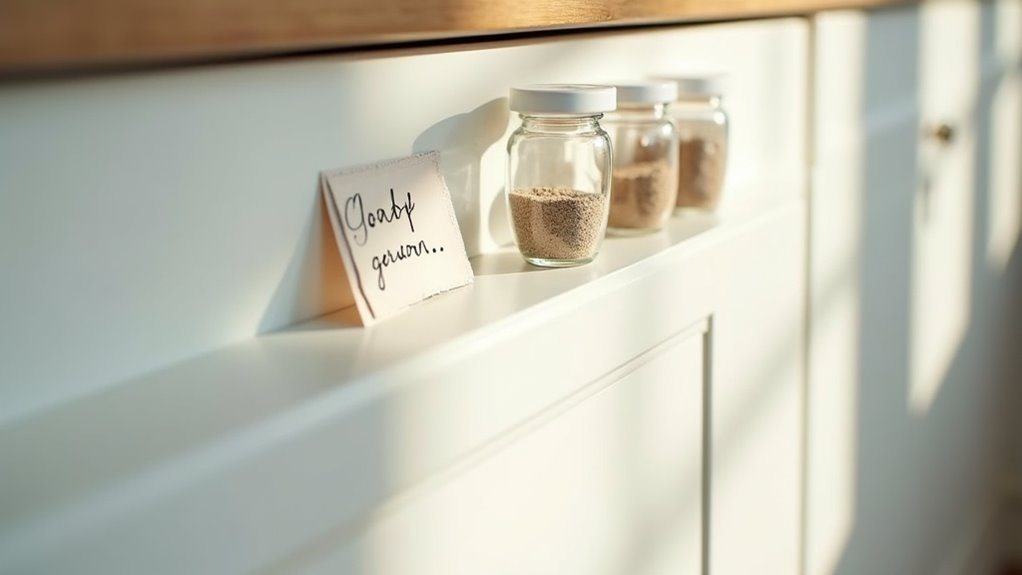
Your kitchen cabinets act like five-star hotels for cockroaches, offering everything these unwelcome guests need to survive and multiply.
These pests target your cabinets because they’re drawn to abundant food sources like crumbs and spilled liquids that accumulate inside. The warmth and moisture near sinks and dishwashers create perfect breeding conditions, while the dark, hidden spaces provide ideal daytime shelter for these nocturnal insects.
Kitchen cabinets provide cockroaches with food, warmth, moisture, and dark hiding spots—creating the perfect environment for these nocturnal pests to thrive.
You’ll find cockroaches munching on more than just food scraps—they’ll consume cardboard packaging, paper products, and even glue from cabinet materials.
Without proper cockroach control measures, including regular cleaning and strategic boric acid placement, you’re practically inviting infestations. Even tiny food particles can trigger major problems, making thorough sanitation essential for protecting your kitchen cabinets.
Selecting the Right Boric Acid for Cabinet Treatment
When selecting boric acid for cabinet treatment, technical grade proves most effective for cockroach control without requiring expensive pharmaceutical-grade purity.
You’ll want to purchase from reputable sources to guarantee quality that effectively targets German cockroaches and other household pests. Alliance Chemical Boric Acid offers reliable formulations perfect for both bait and dust applications against resilient populations.
Choose slow-acting, persistent formulations that provide continuous exposure, maximizing your elimination success rate.
The boric acid you select should feature multiple modes of action without resistance issues, making it indispensable for integrated pest management strategies.
Technical grade delivers the potency needed for cabinet treatment while remaining cost-effective.
Verify your chosen product’s reputation for consistent results before application, guaranteeing your pest control efforts achieve lasting success against stubborn infestations.
Creating Effective Boric Acid Bait Mixtures
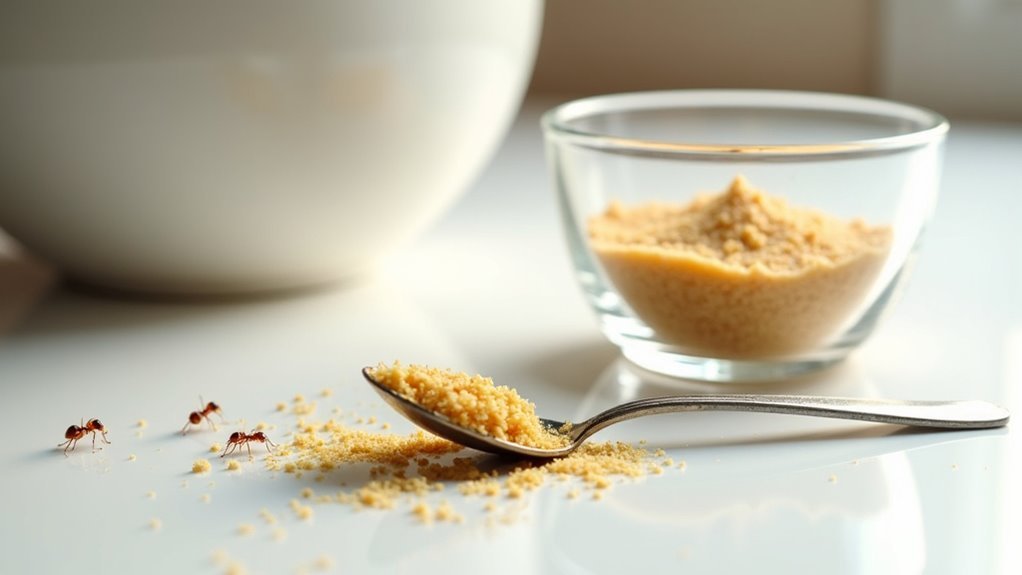
Once you’ve secured quality boric acid for your cabinet treatment, the next step involves crafting bait mixtures that’ll actually attract cockroaches rather than repel them.
Mix 1 part boric acid powder with 3-5 parts food attractants like powdered sugar or flour. Add peanut butter or Karo syrup as sticky components to increase appeal.
The ideal boric acid mixture combines one part powder with three to five parts sugar or flour for maximum roach attraction.
Even distribution is essential—too much boric acid kills roaches before they share the toxicant with others. This control strategy requires patience and consistent application over several weeks for noticeable population reduction.
Place baits in tamper-resistant containers near water sources and food areas in warm, dark cabinet spaces. Once roaches ingest the mixture, they’ll spread the poison throughout their colony.
Strategic Placement of Baits in Cabinet Areas
Three critical factors determine bait placement success: location, spacing, and accessibility. You’ll want to target warm, moist, dark hiding places where roaches naturally congregate in your kitchen cabinets.
| Location | Spacing Guidelines |
|---|---|
| Under sinks | 6-12 inches apart |
| Cabinet corners | Every corner area |
| Behind appliances | Along baseboards |
| Near plumbing | Around pipe entries |
Position your boric acid baits strategically using tamper-resistant bait stations to protect pets and children while ensuring roach access. Place them discreetly in cabinet corners and under sinks where these pests hide. Store all food items in airtight containers and maintain clean surfaces to make your baits more attractive. Monitor placements regularly for effective pest control, replacing consumed baits every few weeks to maintain your kitchen cabinets’ defense system.
Applying Boric Acid Dust in Hard-to-Reach Spaces
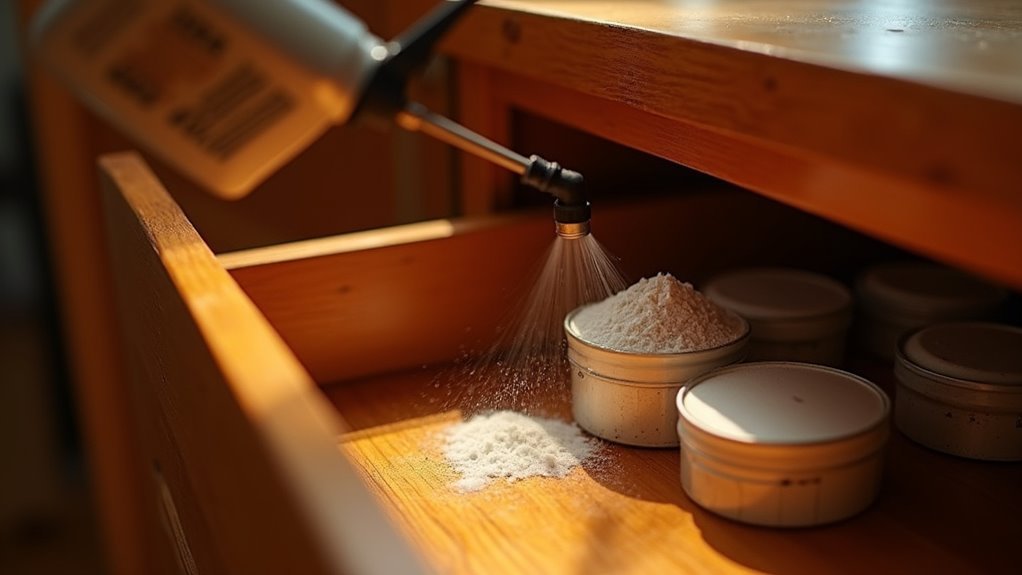
While baits work effectively in open areas, applying boric acid dust reaches the hidden spaces where cockroaches actually live and breed.
Boric acid dust penetrates the concealed breeding grounds that traditional baits simply cannot reach in your home.
You’ll need a bulb duster to distribute a fine layer in cracks, crevices, and wall voids. Focus on areas near plumbing and electrical lines, as these common entry points provide damp conditions roaches prefer.
Don’t apply boric acid dust in frequently wet areas like under sinks, as moisture destroys its effectiveness.
Check and replenish dust regularly since environmental factors diminish its pest control power over time.
Safety’s essential when you apply boric acid – always wear a dust mask and gloves to prevent inhalation and skin contact.
This targeted approach guarantees your hard-to-reach spaces become inhospitable to cockroaches.
Safety Precautions for Indoor Cabinet Applications
Kitchen cabinets require extra safety measures when you’re applying boric acid for pest control. Since these areas store food and cooking supplies, you’ll need to take specific safety precautions to protect children and pets from exposure.
Follow these essential guidelines for safe cabinet applications:
- Use tamper-resistant bait stations to prevent accidental ingestion by curious children and pets.
- Keep boric acid away from food surfaces including dishes, utensils, and preparation areas.
- Wear gloves when handling boric acid and wash hands thoroughly afterward to prevent skin irritation.
Apply small amounts only in cracks and crevices rather than open surfaces.
Clean up spills immediately and regularly maintain treated areas to prevent residue contact with food or hands.
These precautions guarantee effective pest control while maintaining kitchen safety.
Monitoring and Maintaining Your Treatment Plan
You’ll need to actively track your boric acid treatment’s effectiveness to guarantee you’re making real progress against roach infestations.
Check your baits every two to three weeks and replace any that have become hard, moldy, or less appealing to pests.
Don’t let expired baits sit around – fresh, attractive baits are essential for maintaining consistent results in your pest control efforts.
Track Treatment Progress
Effective boric acid treatments require consistent monitoring to guarantee you’re making progress against cockroach infestations.
Tracking treatment progress involves systematically documenting pest control activities to assess your strategy’s effectiveness.
Monitor your boric acid campaign through these essential tracking methods:
- Document bait consumption patterns – Note how frequently you’re replenishing boric acid baits, as increased consumption indicates active roach populations engaging with your treatment.
- Maintain detailed activity logs – Record sightings, trap catches, and fresh signs like droppings or shed skins to identify trends and necessary adjustments.
- Deploy sticky traps strategically – Use these monitoring tools to track movement patterns and population levels throughout your kitchen cabinets.
Regular assessment helps you determine whether your current approach needs modification or if you’re successfully reducing the infestation.
Replace Expired Baits
Once you’ve established your tracking system, maintaining fresh and potent bait stations becomes your next priority for sustained pest control success.
You’ll need to replace expired baits every two to three weeks to maintain their effectiveness against your roach problem. Check each boric acid station for consumption, dust contamination, or degradation that reduces potency.
Use sticky traps alongside your baits to monitor activity levels and determine if your control methods are working effectively. If you notice increased cockroach sightings, refresh baits immediately rather than waiting for the scheduled replacement.
Keep detailed logs of replacement dates to establish a consistent routine. This proactive approach guarantees your ongoing treatment plan remains effective in managing cockroach populations throughout your kitchen cabinets.
Combining Boric Acid With Other Cabinet Control Methods
While boric acid works effectively on its own, combining it with other pest control methods creates an all-inclusive defense system that dramatically improves your chances of eliminating cockroaches from your kitchen cabinets.
Here’s how to maximize your Boric Acid Around cabinet treatment:
- Mix with diatomaceous earth – This combination disrupts roach metabolism while damaging their exoskeletons, promoting faster dehydration and death.
- Apply alongside cockroach gel baits – The gel attracts roaches to consume both treatments, allowing them to spread toxins throughout their colony.
- Remove Food sources and seal entry points – Clean cabinets thoroughly and focus on sealing cracks to prevent new infestations.
Monitor progress using glue traps to gauge activity levels.
If infestations persist, consider professional pest control services for thorough treatment.
Frequently Asked Questions
Can You Put Boric Acid in Kitchen Cabinets?
You can put boric acid in kitchen cabinets for pest control, but you’ll need to place it in hidden areas away from food surfaces and use tamper-resistant containers to protect children and pets.
Where Not to Put Boric Acid in Kitchen?
Don’t put boric acid on countertops, near food prep areas, cooking utensils, or pet feeding zones. Avoid children’s play areas and moist spaces like under sinks where it’s less effective.
Why Am I Seeing More Roaches After Using Boric Acid?
You’re seeing more roaches because boric acid initially attracts them before killing them. The poison works slowly over days or weeks, so roaches continue appearing while ingesting it.
How Do You Clean Cabinets After Roach Infestation?
Remove everything from cabinets and vacuum thoroughly. Wash all dishes with hot soapy water. Wipe surfaces with vinegar solution. Let dry completely before restocking. Consider adding bay leaves as natural deterrents.
In Summary
You’ve now got the tools to tackle cockroach problems in your kitchen cabinets effectively. Remember to apply boric acid strategically, maintain consistent monitoring, and always prioritize safety around food storage areas. Don’t rely solely on boric acid—combine it with proper sanitation and sealing entry points for maximum results. Stay patient and persistent with your treatment plan, as it may take several weeks to see complete elimination of these persistent pests.

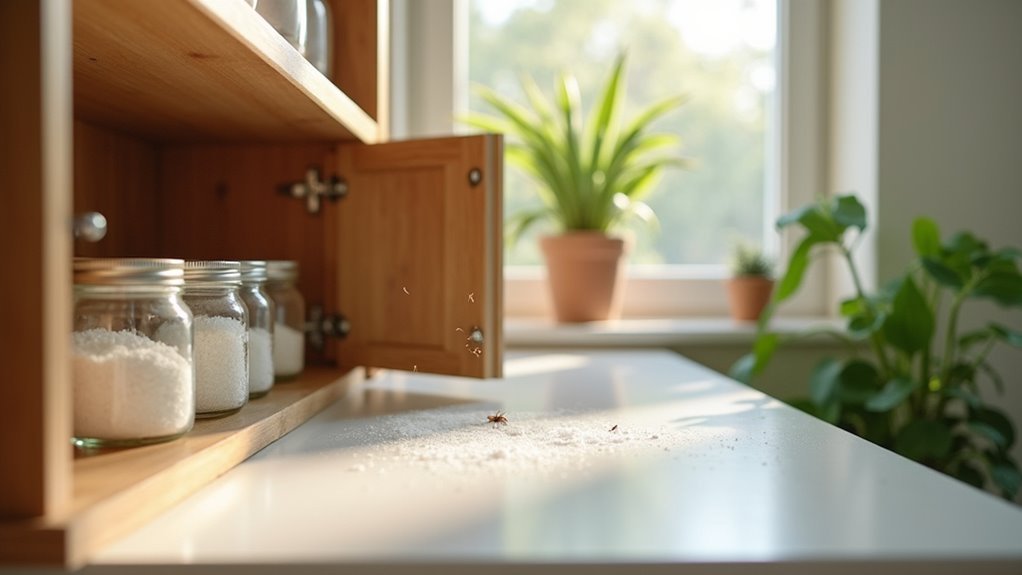
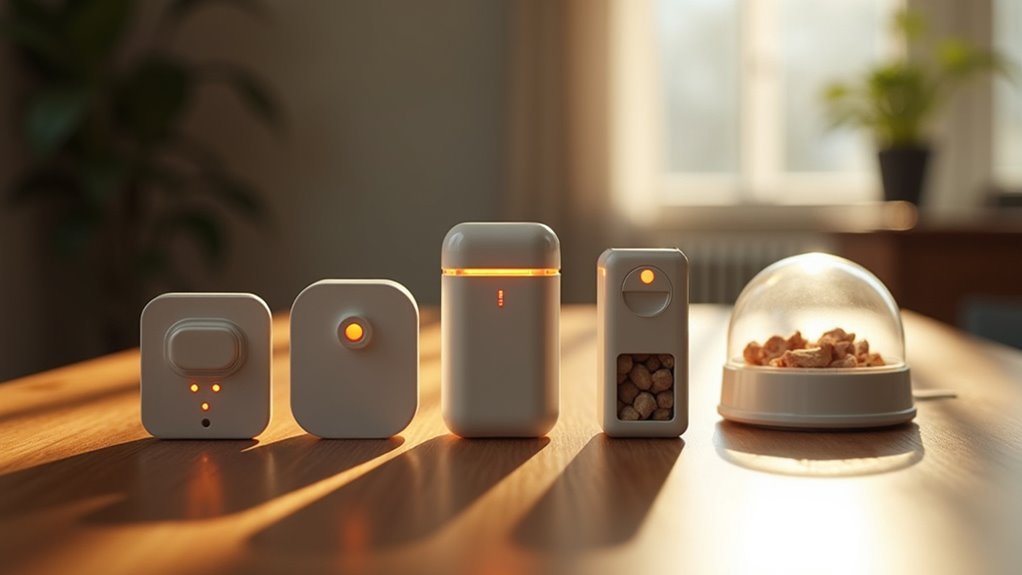

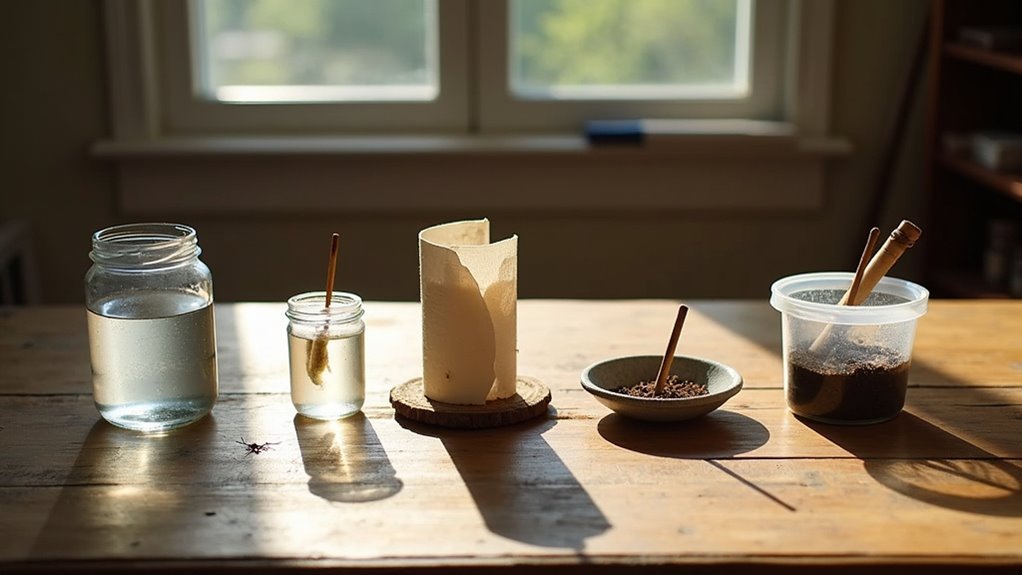
Leave a Reply